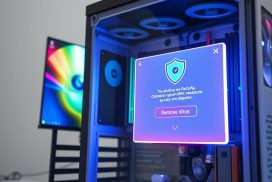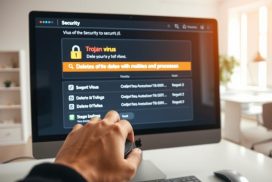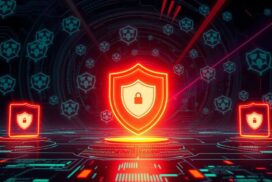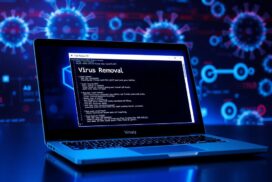Malicious Software Removal: Best Practices for Internet Users
Welcome to our comprehensive guide on malicious software removal and best practices for internet users. In an increasingly digital world, it is crucial to protect your computer systems and networks from the growing threat of malware. Malicious software, commonly known as malware, is designed to cause harm and compromise the security of your devices.
In this article, we will explore the different types of malware that internet users need to be aware of. We will also delve into the key steps involved in the malware removal process and provide you with seven best practices to defend against malware attacks. By implementing these strategies, you can enhance your online security and reduce the risk of falling victim to malicious software.
Before we get started, let’s take a moment to understand the severity of the ongoing battle against malware and the importance of staying informed about the latest cybersecurity practices.
Understanding Malware: Types and Impacts
Malware attacks have been on the rise over the past decade, experiencing a significant increase of 86.38% between 2017 and 2018. The COVID-19 pandemic has further exacerbated this trend, resulting in unprecedented levels of damage. Malware, or malicious software, poses a grave threat to individuals and organizations, causing disruptions to hardware and software, stealing sensitive data, and gaining unauthorized access to networks.
In order to effectively combat malware, it is crucial to have a clear understanding of the different types that exist. Some of the common types of malware include:
- Ransomware: This type of malware encrypts user data and demands a ransom in exchange for its release.
- Viruses: Viruses infect host files and replicate themselves, causing damage to the system.
- Worms: Worms spread independently, exploiting vulnerabilities in network connections.
- Bots: Bots are automated software programs that allow attackers to remotely control infected computers, forming a network of compromised devices known as a botnet.
- Keyloggers: Keyloggers record keystrokes to capture sensitive information, such as passwords and credit card details.
- Trojans: Trojans disguise themselves as legitimate software or files to deceive users into executing them, granting attackers unauthorized access to the system.
Understanding these different types of malware is essential for implementing effective security measures and safeguarding against potential attacks.
Malware attacks can have severe consequences, compromising the privacy and security of individuals and organizations. It is crucial to adopt proactive measures to protect against these threats and minimize their impacts.
To further illustrate the impacts of malware, consider the following statistics:
| Statistics | |
|---|---|
| In 2021, global ransomware damages were estimated to reach | $20 billion |
| The average cost of a malware attack on a company is | $4.4 million |
| Approximately | 230,000 new malware samples |
| On average, it takes | 46 days |
The table above highlights the financial and time-related impacts of malware attacks. These data underscore the urgency for individuals and organizations to address the growing threat of malware and implement stringent security measures to protect their systems.
Steps in the Malware Removal Process
If a malware infection is suspected or confirmed, it is crucial to take immediate action to remove the malware from the system. The malware removal process involves seven key steps:
- Isolate the infected system: Disconnect the infected computer from the network or the internet to prevent further spread of the malware.
- Identify the malware: Use trusted antivirus software to scan the system and identify the type of malware present.
- Research the malware: Conduct thorough research to gather information about the identified malware, including its characteristics, potential impacts, and recommended removal procedures.
- Select a removal method: Based on the research findings, determine the most appropriate removal method. This may include using a specialized removal tool or following manual removal procedures.
- Implement the removal procedure: Follow the step-by-step instructions for removing the malware. This may involve disabling startup processes, deleting malicious files, modifying system settings, or performing system restores.
- Scan for remaining threats: After removing the malware, perform another scan to ensure that no residual threats are present.
- Enable security measures: Activate or update security software, firewall, and other protective measures to prevent future malware infections.
By following these key steps, users can effectively remove malware from their systems and reduce the risk of further damage or data breaches.
“The key steps in the malware removal process involve isolating the infected system, identifying the malware, researching the malware, selecting a removal method, implementing the removal procedure, scanning for remaining threats, and enabling security measures.”
Best Practices for Protection Against Malware Attacks
Protecting your computer and network from malware attacks is essential in today’s digital landscape. By following these top seven best practices, you can significantly reduce the risk of falling victim to malicious software:
- Keep your software up to date: Regularly update your operating system, web browsers, and other software to ensure you have the latest security patches that protect against known vulnerabilities.
- Install reliable antivirus software: Choose a reputable antivirus program and keep it updated. Use real-time scanning to detect and remove malware threats before they can cause harm.
- Enable automatic system updates: Enable automatic updates to ensure your system receives the latest security patches without having to manually install them.
- Beware of phishing emails: Exercise caution when opening emails, especially those from unknown senders or with suspicious attachments. Avoid clicking on links within emails unless you are entirely sure of their legitimacy.
- Use strong, unique passwords: Create strong passwords that include a combination of letters, numbers, and special characters. Avoid using the same password across multiple accounts.
- Be cautious when downloading software or files: Only download software and files from trusted sources. Be wary of freeware or shareware applications that may contain hidden malware.
- Regularly back up your data: Create regular backups of your important files and data. This ensures that even if you do fall victim to a malware attack, you can restore your systems and prevent permanent data loss.
By implementing these best practices, you can significantly enhance your protection against malware attacks and safeguard your valuable data and systems.
Real-World Example
“Following the best practices for protection against malware attacks is crucial in today’s interconnected world. We have seen a significant rise in cyber threats, with hackers employing sophisticated techniques to target individuals and organizations. By staying vigilant and adhering to these best practices, you can stay one step ahead of cybercriminals and protect your digital assets.”
| Best Practice | Description |
|---|---|
| Keep your software up to date | Regularly update your operating system, web browsers, and software to apply security patches and protect against known vulnerabilities. |
| Install reliable antivirus software | Choose a reputable antivirus program and keep it updated to detect and remove malware threats. |
| Enable automatic system updates | Enable automatic updates to ensure your system receives the latest security patches. |
| Beware of phishing emails | Exercise caution when opening emails and avoid clicking on suspicious links or attachments. |
| Use strong, unique passwords | Create strong passwords and avoid using the same password across multiple accounts. |
| Be cautious when downloading software or files | Only download software and files from trusted sources to avoid malware infections. |
| Regularly back up your data | Create regular backups of your important files and data to mitigate the impact of a malware attack. |
The Ongoing Battle Against Malware
Malware attacks pose an ongoing battle for individuals and organizations, constantly evolving and finding new ways to exploit vulnerabilities. In 2022, the threat of malware attacks remains significant, highlighting the critical need for robust cybersecurity measures to safeguard sensitive data and maintain the integrity of computer systems.
Staying vigilant and up-to-date on the latest cybersecurity practices is essential in protecting against these evolving threats. Regularly assessing and updating security measures can help identify and address potential weaknesses before they are exploited by cybercriminals. By implementing robust cybersecurity protocols, individuals and organizations can fortify their defenses against these malicious attacks.
Key Strategies in the Ongoing Battle:
- Continual Assessment and Updates: Regularly review and update security measures, including antivirus software, firewalls, and intrusion detection systems. This proactive approach can help identify and address potential vulnerabilities before they can be exploited by malware.
- Stay Informed on Emerging Threats: Keep abreast of the latest malware trends and attack techniques. Stay informed through reliable sources, such as cybersecurity blogs, industry reports, and newsletters, to stay one step ahead of cybercriminals.
- Ongoing Education and Training: Engage employees in regular education and training sessions to raise awareness of cybersecurity risks and best practices. Teach them to recognize phishing emails, suspicious websites, and potential indicators of malware attacks.
- Implement Multifactor Authentication: Require users to authenticate their identities using multiple factors, such as passwords, fingerprints, or one-time verification codes. This extra layer of security can significantly reduce the risk of unauthorized access to sensitive information.
- Secure Remote Access: With the rise of remote work, ensure secure access to company networks through virtual private networks (VPNs) and encrypted connections. This helps protect against unauthorized access and data breaches.
- Regular Data Backups: Implement a robust backup strategy and regularly backup critical data to prevent loss in the event of a malware attack. Test the backups periodically to ensure their integrity and reliability.
- Monitor and Respond: Continuously monitor systems for any signs of a malware attack. Implement real-time monitoring tools and establish response plans to contain and mitigate the impact of an attack swiftly.
By adopting these best practices, individuals and organizations can strengthen their cybersecurity posture, reducing the risk of falling victim to malware attacks. The ongoing battle against malware requires a proactive and comprehensive approach to protect critical systems, sensitive data, and maintain business continuity.
How Malware Infects Systems
Malware infections can occur through various methods, putting computer systems and networks at risk. Awareness of these methods and exercising caution is crucial to minimize the risk of malware infection.
Email attachments are a common vehicle for malware infection. Cybercriminals often disguise malicious code within seemingly harmless attachments, such as documents or compressed files. Users may unknowingly download and open these attachments, triggering the installation of malware onto their systems.
Fake internet ads are another method used by cyber attackers to distribute malware. These ads may appear legitimate and enticing, offering attractive deals or free downloads. Clicking on these ads can redirect users to websites that host malware, leading to a successful infection.
Downloading software or files from untrusted sources is a risky practice. Malicious actors may create fake websites or upload infected files to legitimate platforms, tricking users into downloading malware. It is important to verify the authenticity of the source and only download from trusted websites or official app stores.
Users often fall victim to malware infections by clicking on seemingly legitimate links or attachments. Cybercriminals employ various social engineering tactics to deceive users into initiating the malware installation process. It is essential to exercise caution and be skeptical of unsolicited emails, suspicious websites, or unexpected attachments.
To minimize the risk of malware infection:
- Be cautious when opening emails from unknown senders or emails that seem suspicious.
- Avoid downloading files or software from untrusted sources.
- Regularly update operating systems, applications, and security software to patch vulnerabilities.
- Use strong and unique passwords for all online accounts.
- Enable automatic software updates to ensure the latest security patches are installed.
- Implement a reliable antivirus and anti-malware solution.
- Exercise caution when visiting websites, especially those with a questionable or unfamiliar reputation.
By adopting these best practices and remaining vigilant, users can significantly reduce the risk of malware infection and protect their systems from the damaging impacts of malicious software.
Conclusion
Protecting against malware requires a proactive approach that involves understanding the different types of malware, following the steps in the malware removal process, and implementing best practices for protection. By staying informed about the latest malware trends and utilizing reliable security software, individuals and organizations can fortify their defenses against cyber threats.
One of the most crucial aspects of malware prevention is maintaining strong passwords. Using a combination of uppercase and lowercase letters, numbers, and symbols can significantly enhance the security of online accounts. Regularly updating passwords and avoiding the use of common phrases or personal information further strengthens resilience against potential breaches.
In addition to strong passwords, practicing safe browsing habits is vital. Avoid clicking on suspicious links or downloading files from untrusted sources, as these can easily be vehicles for malware infections. By exercising caution and verifying the legitimacy of websites and email attachments, users can minimize the risk of inadvertently installing malware onto their systems.
Furthermore, staying informed about emerging malware threats is key. Regularly educating oneself and employees about the latest security practices and emphasizing the importance of cybersecurity awareness can create a culture of vigilance. Engaging in ongoing education and training can empower individuals to recognize potential malware warning signs and take appropriate action to prevent infection.
FAQ
What is malware?
Malware, short for malicious software, is a type of code developed by cyber attackers with the intention to cause damage to computer systems and networks.
What are the different types of malware?
The different types of malware include ransomware, viruses, worms, bots, keyloggers, and Trojans.
How do I remove malware from my system?
The malware removal process involves seven key steps which are detailed in the article.
What are the best practices for protecting against malware attacks?
The top seven best practices for protecting against malware attacks are outlined in the article.
How do malware attacks impact individuals and organizations?
Malware attacks can cause disruptions to hardware and software, steal sensitive data, and gain unauthorized access to networks.
How does malware infect systems?
Malware can infect systems through various methods such as email attachments, fake internet ads, and downloading software or files from untrusted sources.












